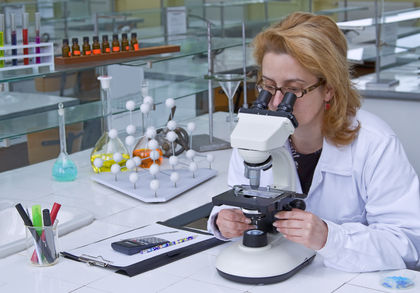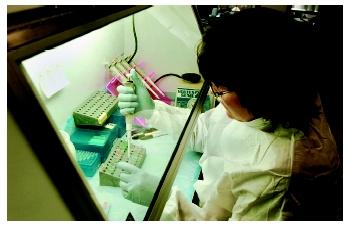Forensic DNA Analysis

Forensic DNA analysis is the use of deoxyribonucleic acid (DNA) specimens in legal proceedings. Just as people can leave fingerprints when they touch

A man could be associated with a rape in a private home by several types of evidence: he may have smoked a cigarette and left the butt outside the house; he may have cut his hand while breaking a window to get inside; or he may have left semen on the victim's body. For each type of evidence, DNA could be used to strengthen the case against a suspect identified by the police by some other means. If the DNA profile from a blood sample or cheek cell scrape is found to match that at the scene of the crime, the suspect is implicated in the crime. If the police have no suspect, they can take the crime scene profiles and use them to search a database of profiles of previously convicted offenders, in the same way that fingerprint records can be searched.
Not only can DNA be used to associate people with crimes, but it can also be used to exonerate them. Several people have been released from prison because DNA testing, not available when they were convicted, has since shown that it could not have been their blood, for example, on an item of evidence.
These forensic uses of DNA rest on the fact that DNA is found in every nucleated cell in the body and is the same in all those cells. The other great advantage for DNA as a means of identification is that it is transmitted from parent to child. Paternity disputes can be settled by comparisons of the DNA profiles of mother, child, and alleged father. Just one or two components of the child's DNA profile may be sufficient to exclude a man from being the father, whereas if the man and child match paternal alleles at many loci (sites on a chromosome ), it may be highly probable that the man is the child's father.
The sharing of some aspects of DNA profiles among family members is also used to identify remains after mass disasters, such as aircraft crashes or battles of war. Particularly when bone or hair is used for identification, mitochondrial DNA may be preferred over nuclear DNA because it is more abundant in the cell and because its smaller size means that it is less susceptible to degradation over time.
Exclusion by DNA is taken to be absolute. If the DNA profile from a bloodstain is different from that of a suspect in a crime, that person could not be the source of the stain. Failure to exclude a "match" is not absolute, however, because two people may have the same profile. On average, two people are expected to differ at the DNA level about once per 1,000 base pairs . This means that they have about three million differences, and this would certainly be detected if complete DNA sequences were used in forensic science. Current technology, however, limits DNA profiles to just a few genetic markers, often thirteen in the United States, and coincidental matches have been found for up to six markers.
When a person is not excluded as being the source of an evidentiary DNA profile , the strength of the evidence is given in terms of probabilities. Although the evidentiary profile may match the DNA of the suspect, this is not proof that the stain came from the suspect. All that can be said is that there is a certain probability that it did. Because related people share more markers, the probabilities may need to allow for the suspect being a close relative to the person who was the source of the evidence, and the calculations should also allow for the chance of people in the same subpopulation having the same DNA profiles because of a shared ancestry or evolutionary history.
There are two probabilities the forensic scientist can determine. The first probability is for obtaining a match between the suspect's profile and the evidentiary profile if the suspect is the source of the evidentiary profile. Obtaining a match in this case is usually taken as certain. This probability has a value of one. The second probability is for obtaining a match between the suspect's profile and the evidentiary profile if the suspect is not the source of the evidentiary profile. This probability varies with the tests done and the characteristics of the population in the area of the crime scene. In many cases, it has the value of one in one million, or much less.
Thus, what the forensic scientist reports is: "If the suspect is innocent, there is a one in one million chance of obtaining this match." Far too often that statement is misinterpreted as, "If this DNA matches, there is a one in one million chance the suspect is innocent." The reversal of proposition and conclusion is known as the Prosecutor's Fallacy. It is a very common misinterpretation of DNA forensic evidence by prosecutors, juries, and the press.
To understand why it is wrong to reverse these clauses, consider this analogous example. If one is a citizen of Spain, there is a 95 percent probability that one speaks Spanish. However, if one speaks Spanish, it does not follow that there is a 95 percent probability that one is a citizen of Spain—there are many other likely sources of Spanish speakers. Similarly, if the DNA matches, it does not follow that the suspect is the source. In a city of ten million people, there are, on average, nine other people whose DNA would match the evidentiary sample to the same degree of certainty that the suspect's did (one in one million). With only the DNA evidence, each of them might be regarded as being equally suspect. Many other circumstances, including age and sex, could be evidence against such equal probabilities, of course, and the exact number of people with the same profile in the city is unkown. Only by considering other incriminating evidence can the prosecutor proceed with the case against the suspect.
SEE ALSO DNA ; DNA Sequencing ; Electrophoresis ; Mitochondrion ; Polymerase Chain Reaction ; Separation and Purification of Biomolecules
B. S. Weir
Bibliography
Evett, Ian W., and Bruce S. Weir. Interpreting DNA Evidence: Statistical Genetics for Forensic Scientists. Sunderland, MA: Sinauer Associates, 1998.
Comment about this article, ask questions, or add new information about this topic: